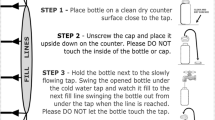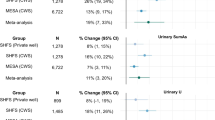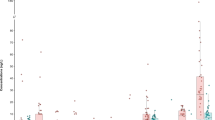Abstract
Human biomonitoring data show that exposure to perchlorate is widespread in the United States. The predominant source of intake is food, whereas drinking water is a less frequent and far smaller contributor. We used spot urine samples for over 2700 subjects and estimated 24 h intake using new creatinine adjustment equations. Merging data from surveys of national health (NHANES) with drinking water monitoring (UCMR), we categorized survey participants according to their potential exposure through drinking water or food. By subtracting daily food doses of perchlorate from the oral reference dose (RfD), we derive an allowances for perchlorate in tap water for several populations. The calculated mean food perchlorate dose in the United States was 0.081 μg/kg/day compared to 0.101 μg/kg/day for those who also had a potential drinking water component. The calculated 95th percentile doses, typically falling between 0.2 and 0.4 μg/kg/day, were well below the RfD (0.7 μg/kg/day) in all populations analyzed. Children aged 6–11 years had the highest mean perchlorate doses in food (0.147 μg/kg/day), with an additional water contribution of only 0.003 μg/kg/day representing just 2% of exposure. Pregnant women had a mean food dose of 0.093 vs 0.071 μg/kg/day for all women of reproductive age. At the 95th percentile intake for both the total population and women of child-bearing age (15–44), the perchlorate contribution from food was 86% and from drinking water 14% (respectively, 30% and 5% of the RfD). At the mean for the same groups, the food to water contribution ratio is approximately 80:20. We calculate that an average 66 kg pregnant woman consuming a 90th percentile food dose (0.198 μg/kg/day) could also drink the 90th percentile of community water for pregnant women (0.033 l/kg/day) containing 15 μg/l perchlorate without exceeding the 0.7 μg/kg/day reference dose.
This is a preview of subscription content, access via your institution
Access options
Subscribe to this journal
Receive 6 print issues and online access
$259.00 per year
only $43.17 per issue
Buy this article
- Purchase on Springer Link
- Instant access to full article PDF
Prices may be subject to local taxes which are calculated during checkout

Similar content being viewed by others
References
Anbar M., Guttman S., and Lewitus Z. The mode of action of perchlorate ions on the iodine uptake of the thyroid gland. Int J Appl Radiat Isot 1959: 7: 87–96.
Becker D.V., Braverman L.E., Delange F., Dunn J.T., Franklyn J.A., Hollowell J.G., Lamm S.H., Mitchell M.L., Pearee E., Robbins J., and Rovet J.F. Iodine supplementation for pregnancy and lactation — United States and Canada: recommendations of the American thyroid association. Thyroid 2006: 10: 949–951.
Blount B.C., Pirkle J.L., Osterloh J.D., Valentin-Blasini L., and Caldwell K.L. Urinary perchlorate and thyroid hormone levels in adolescent and adult men and women living in the United States. Environ Health Perspect 2006: 114 (12): 1865–1871.
Blount B.C., Valentin-Blasini L., Osterloh J.D., Mauldin J.P., and Pirkle J.L. Perchlorate exposure of the US population, 2001–2002. J Expo Sci Environ Epidemiol 2007: 17: 400–407 .
Boeniger M.F., Lowey L.K., and Rosenberg J. Interpretation of urine results used to assess chemical exposure with emphasis on creatinine adjustments: a review. Am Ind Hyg Assoc J 1993: 54 (10): 615–627.
Braverman L.E., Pearce E.N., Xuenmei H., Pine S., Seeley M., Bech B., Mangani B., Blount B., and Firek A. Effects of six months of daily low-dose perchlorate exposure on thyroid function in healthy volunteers. J Clin Endocrinol Metab 2006: 91 (7): 2721–2724.
Caldwell K.L., Jones R.T., and Hollowell J.G. Urinary iodine concentration: United States National Health and Nutrition Examination Survey 2001–2002. Thyroid 2005: 15 (7): 692–699.
CDC. Fourth National Report on Human Exposure to Environmental Chemicals. Centers for Disease Control and Prevention, 2009, pp 243–246. Available at http://www.cdc.gov/exposurereport/pdf/FourthReport.pdf.
CDC. National Health and Nutrition Examination Survey 2004, 2004 Available at: http://www.cdc.gov/nchs/nhanes.htm.
Cockroft D.W., and Gault M.H. Prediction of creatinine clearance from serum creatinine. Nephron 1976: 16: 31–41.
Crump K.S., and Gibbs J.P. Benchmark calculations for perchlorate from three human cohorts. Environ Health Perspect 2005: 113 (8): 1001–1008.
Dasgupta P.K., Dyke J.V., Kirk A.B., and Jackson W.A. Perchlorate in the United States. Analysis of relative source contributions to the food chain. Environ Sci Technol 2006: 40 (21): 6608–6614.
Dasgupta P.K., Yining L., and Dyke J.V. Iodine nutrition: iodine content of iodized salt in the United States. Environ Sci Technol 2008: 42 (4): 1315–1323.
Dasgupta P.K., Perchlorate: a couse for iodine deficiency? Environ Chem 2009: 6: 7–9.
DeGroef B., Decallonne B.R., Van der Geyten S., Darras V.M., and Bouillon R. Perchlorate versus other environmental sodium/iodide symporter inhibitors: potential thyroid-related health effects. Eur J Endocrinol 2006: 155: 17–25.
Divi R.L., Chang H.C., and Doerge D.R. Anti-thyroid isoflavones from soybean: isolation, characterization, and mechanisms of action. Biochem Pharmacol 1997: 54 (10): 1087–1096.
El Aribi H., Le Blanc Y.J.C., Antonsen S., and Sakuma T. Analysis of perchlorate in foods and beverages by ion chromatography couple with tandem mass spectrometry (IC-ESI-MS/MS). Anal Chim Acta 2006: 567 (1): 39–47.
Gibbs J.P., Ahmad R., Crump K.S., Houck D.P., Leveille T.S., Findley J.E., and Francis M. Evaluation of a population with occupational exposure to airborne ammonium perchlorate for possible acute or chronic effects on thyroid function. J Occup Environ Med 1998: 40 (12): 1072–1082.
Greer M.A., Goodman G., Pleus R.C., and Greer S.E. Health effects assessment for environmental perchlorate contamination: the dose response for inhibition of thyroidal radioiodine uptake in humans. Environ Health Perspect 2002: 110 (9): 927–937.
Grubbs F. Procedures for detecting outlying observations in samples. Technometrics 1969: 11: 1–21.
Hogue C. Rocket fueled river. Chem Eng News 2003: 81 (33): 37–46.
Kirk A.B., Dyke J.V., Martin C.F., and Dasgupta P.K. Temporal patterns in perchlorate thiocyanate, and iodide excretion in human milk. Environ Health Perspect 2007: 115: 182–186.
Kirk A.B., Martinelango P.K., Tian K., Dutta A., Smith E.E., and Dasgupta P.K. Perchlorate and iodide in dairy and breast milk. Environ Sci Technol 2005: 39: 2011–2017.
Lamm S.H., Braverman L.E., Li F.X., Richman K., Pino S., and Howearth G. Thyroid health status of ammonium perchlorate workers: a cross-sectional occupational health study. J Occup Environ Med 1999: 41 (4): 248–260.
Lawrence J.E., Lamm S.H., Pino S., Richman K., and Braverman L.E. The effect of short-term low-dose perchlorate on various aspects of thyroid function. Thyroid 2000: 10 (8): 659–663.
MA DEP. (2005) The occurrence and sources of perchlorate in Massachusetts. Draft Report. Massachusetts Department of Environmental Protection. Available at: http://www.mass.gov/dep/.
Mage D.T., Allen R.H., Gondy G., Smith W., Barr D.B., and Needham L.L. Estimating pesticide dose from urinary pesticide concentration data by creatinine correction in the Third National Health and Nutrition Examination Survey (NHANES-III). J Expo Anal Environ Epidemiol 2004: 14: 457–465.
Mage D.T., Allen R.H., and Kodali A. Creatinine corrections for estimating children's and adult's pesticide intake doses in equilibrium with urinary pesticide and creatinine concentrations. J Expo Anal Environ Epidemiol 2008: 18 (4): 360–368.
Mendez W., Dederick E., and Cohen J. Drinking water contribution to aggregate perchlorate intake of reproductive-age women in the United States estimated by dietary intake simulation and analysis of urinary excretion data. J Expo Sci Environ Epidemiol 2010: 20 (3): 288–297.
Murray C.W., Egan S.K., Kim H., Beru N., and Bolger P.M. US Food and Drug Administration's Total Diet Study: dietary intake of perchlorate and iodine. J Expo Sci Environ Epidemiol 2008, 1–10.
National Research Council (NRC). Health Implications of Perchlorate Ingestion. National Academies Press, Board on Environmental Studies and Toxicology: Washington, DC 2005.
Paulus B., Bazar M., Salice C., Mattie D., and Major M. Perchlorate inhibition of iodide uptake in normal and iodine-deficient rats. J Toxicol Environ Health A 2007. 70: 1142: 1149.
Pearce E.N., Leung A.M., Blount B.C., Bazrafshan H.R., He X., Pino S., Valentin-Blasini L., and Braverman L.E. Breast milk iodine and perchlorate concentrations in lactating Boston-area women. J Clin Endocrinol Metab 2007: 92 (5): 1673–1677.
Russell R.M., Beard J.L., Cousins R.J., Dunn J.T., Ferland G., Hambidge K.M., Lynch S., Penland J.G., Ross A.C., Stoecker B.J., Suttie J.W., Turnlund J.R., West K.P., Zlotkin S.H., Munro I.C., Murphy S.P., Young V.R., Trumbo P.R., and Yates A.A. Dietary reference intakes for vitamin A, vitamin K, arsenic, boron, chromium, copper, iodine, iron, manganese, molybdenum, nickel, silicon, vanadium, and zinc. National Academies Press, 2001.
Sanchez C.A., Barraj L.M., Blount B.C., Scrafford C.G., Valentin-Blasini L., Smith K.M., and Krieger R.I. Perchlorate exposure from food crops produced in the lower Colorado River region. J Expo Sci Environ Epidemiol 2009: 19 (4): 359–368.
Sanchez C.A., Crump K.S., Krieger R.I., Khandaker N.R., and Gibbs J.P. Perchlorate and nitrate in leafy vegetables of North America. Environ Sci Technol 2005: 59 (24): 9391–9397.
Steinmaus C., Miller M.D., and Howd R. Impact of smoking and thiocyanate on perchlorate and thyroid hormone associations in the 2001–2002 National Health and Nutrition Examination Survey. Environ Health Perspect 2007: 115 (9): 1333–1338.
Thorp J.M., Norton P.A., Wall S.S., Kuller J.A., Eucker B., and Wells E. Urinary incontinence in pregnancy and the puerperium: a prospective study. Am J Obstet Gynecol 1999: 181 (2): 266–273.
Tonacchera M., Pinchera A., Dimida A., Ferrarini E., Agretti P., Vitti P., Santini F., Crump K., and Gibbs J. Relative potencies and additivity of perchlorate thiocynate, nitrate and iodide on the inhibition of radioactive iodide uptake by the human sodium iodide symporter. Thyroid 2004: 14: 1012–1019.
Tran N., Valentín-Blasini L., Blount B.C., McCuistion C.G., Fenton M.S., Gin E., Salem A., and Hershman J.S. Thyroid-stimulating hormone increases active transport of perchlorate into thyroid cells. Am J Physiol Endocrinol Metab 2008: 294: E802–E806 .
Urbansky E., Collette T., Robarge W., Hall W., Skillen J., and Kane P. Survey of fertilizers and related materials for perchlorate (ClO4−), 2001; EPA/600/R-01/tba.
US EPA. Estimated per capita water ingestion and body weight in the United States–an update. EPA-822-R-00-001, 2004 Office of Water, Office of Science and Technology, US EPA.
US EPA. “Integrated risk information system (IRIS), perchlorate and perchlorate salts.” February 2005. Available at: http://www.epa.gov/iris/subst/1007.htm.
US EPA. Preliminary regulatory determination for perchlorate. Federal Register 2008: 73: 60262–60282.
US EPA Region 9. Perchlorate Monitoring Results. Henderson, Nevada to the Lower Colorado River. December 2005. http://ndep.nv.gov/BCA/file/perchlorateeighthmonrpt123105.pdf.
Yu K.O., Narayanan L., Mattie D.R., Godfrey R.J., Todd P.N., Sterner T.R., Mahle D.A., Lumpkin M.H., and Fisher J.W. The pharmacokinetics of perchlorate and its effect on the hypothalamus-pituitary-thyroid axis in the male rat. Toxic Appl Pharmacol 2002: 182: 148–159.
Acknowledgements
We express our appreciation to Peter Meyer and Deborah Rose at the National Center for Health Statistics (NCHS) for their outstanding cooperation in approving and conducting the data merge.
Author information
Authors and Affiliations
Corresponding author
Ethics declarations
Competing interests
The authors declare no conflict of interest.
Additional information
Supplementary Information accompanies the paper on the Journal of Exposure Science and Environmental Epidemiology website
Supplementary information
Rights and permissions
About this article
Cite this article
Huber, D., Blount, B., Mage, D. et al. Estimating perchlorate exposure from food and tap water based on US biomonitoring and occurrence data. J Expo Sci Environ Epidemiol 21, 395–407 (2011). https://doi.org/10.1038/jes.2010.31
Received:
Accepted:
Published:
Issue Date:
DOI: https://doi.org/10.1038/jes.2010.31
Keywords
This article is cited by
-
The risk of perchlorate and iodine on the incidence of thyroid tumors and nodular goiter: a case-control study in southeastern China
Environmental Health (2022)
-
The science of spin: targeted strategies to manufacture doubt with detrimental effects on environmental and public health
Environmental Health (2021)
-
Update on dietary intake of perchlorate and iodine from U.S. food and drug administration’s total diet study: 2008–2012
Journal of Exposure Science & Environmental Epidemiology (2018)
-
Seasonal Variation and Exposure Risks of Perchlorate in Soil, Indoor Dust, and Outdoor Dust in China
Archives of Environmental Contamination and Toxicology (2018)
-
A review of perchlorate (ClO4 −) occurrence in fruits and vegetables
Environmental Monitoring and Assessment (2017)



